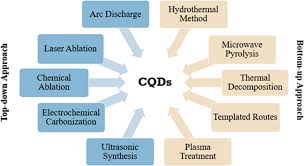4 Great Uses of Carbon Quantum Dots
Carbon Quantum Dots (CQDs) are a fascinating class of nanomaterials that have gained significant attention in the scientific community due to their unique properties. These materials, which are typically smaller than 10 nanometers, possess distinct optical, electronic, and chemical characteristics that make them highly versatile. CQDs are primarily composed of carbon atoms, but they often include oxygen, nitrogen, and other elements. Their remarkable properties, such as photoluminescence, high stability, biocompatibility, and easy synthesis, make them ideal candidates for a wide range of applications.
Here are four great uses of Carbon Quantum Dots (CQDs) that highlight their versatility and potential in various fields:
1. Fluorescent Bioimaging and Medical Applications
One of the most prominent applications of CQDs is in the field of bioimaging. Due to their strong fluorescence and biocompatibility, CQDs are ideal for imaging biological systems, offering an alternative to traditional organic dyes and fluorescent proteins.
- Bioimaging: CQDs exhibit excellent fluorescence properties, which makes them useful for tracking cells and tissues in medical diagnostics and research. Their small size allows them to penetrate biological membranes easily, making them suitable for in vivo imaging, even in deep tissue.
- Medical Diagnostics: CQDs are increasingly being used in disease detection, including the identification of cancerous cells. They can be functionalized to target specific biomolecules, enabling more accurate and efficient diagnosis. Additionally, their photoluminescence properties allow them to serve as contrast agents for imaging technologies like fluorescence microscopy or MRI.
- Drug Delivery: CQDs can be used as nanocarriers for the targeted delivery of drugs. Due to their high surface area and ability to be modified with functional groups, CQDs can be engineered to carry therapeutic agents directly to specific cells or tissues, improving the efficiency of drug delivery while reducing side effects.
2. Environmental Remediation
Another exciting application of CQDs lies in environmental remediation. Their unique properties enable them to effectively address environmental pollution and contamination, particularly in water and air.
- Heavy Metal Ion Detection and Removal: CQDs can be designed to adsorb or detect heavy metals such as lead, mercury, and cadmium from polluted water. Their ability to bind with these metals allows for efficient removal, helping to mitigate water contamination. Some CQDs even exhibit fluorescence changes upon binding with toxic ions, making them valuable for real-time detection of pollutants in environmental monitoring.
- Water Purification: Carbon quantum dots can also be used in water treatment processes. For example, when combined with photocatalysts, CQDs can enhance the degradation of organic pollutants and improve the efficiency of water purification systems. Their role in catalysis is particularly important for breaking down harmful substances like pesticides, dyes, and pharmaceutical residues, making water safe for consumption.
- Air Purification: CQDs have shown promise in air filtration applications, particularly for absorbing harmful gases like carbon dioxide (CO₂) and nitrogen oxides (NOx). Their high surface area and functionalization capabilities make them an effective material for capturing and removing pollutants from the atmosphere, contributing to cleaner air in urban environments.
3. Energy Storage and Conversion
CQDs are also playing a significant role in the development of energy storage and conversion devices. Their unique electronic properties, including high surface area and tunable energy levels, make them highly effective for energy-related applications, especially in the context of sustainable energy technologies.
- Supercapacitors: In energy storage devices such as supercapacitors, CQDs are being explored for their ability to enhance charge storage capacity and cycling stability. When incorporated into electrodes, CQDs help improve the efficiency of energy storage systems, offering faster charging times and longer lifespans compared to traditional materials.
- Batteries: CQDs are also being used to improve the performance of lithium-ion and sodium-ion batteries. Their high conductivity and ability to store and release energy efficiently make them valuable for boosting battery capacity and extending battery life. Researchers are exploring their use in both anode and cathode materials for next-generation batteries.
- Photovoltaic Cells: Another exciting application of CQDs is in solar energy conversion. When integrated into photovoltaic cells, CQDs can improve the efficiency of light absorption and charge transport, contributing to the development of more efficient solar panels. CQDs are particularly valuable in quantum dot solar cells because of their ability to tune the absorption spectrum for optimal energy conversion.
4. Sensors and Detection Systems
The sensing capabilities of Carbon Quantum Dots are another area of growing interest, as they can be employed in a variety of detection systems for both biological and chemical analysis.
- Chemical Sensors: CQDs can be designed to respond to specific chemical stimuli, making them ideal for use in chemical sensors. For instance, CQDs can be used to detect gases, volatile organic compounds (VOCs), or even changes in pH. Their fluorescence changes in response to environmental factors enable sensitive and selective detection, making them useful for real-time monitoring applications.
- Biosensors: CQDs are being used in biosensing applications for the detection of various biomolecules, such as glucose, proteins, and nucleic acids. Their ability to be functionalized with specific receptors allows them to detect biological markers, providing quick and accurate results for diagnostics and medical monitoring.
- Gas Sensors: The ability of CQDs to interact with gases like ammonia, hydrogen, and carbon monoxide is being explored for the development of gas sensors. These sensors can detect harmful gas leaks or pollutants in the air, improving safety in industrial environments and contributing to air quality monitoring.
Conclusion
Carbon Quantum Dots (CQDs) are rapidly becoming one of the most versatile and useful materials in modern science and technology. Their wide range of applications, from bioimaging to energy storage, environmental remediation, and sensing, demonstrates their immense potential across diverse fields. As research into CQDs continues to expand, we can expect even more groundbreaking innovations that leverage their unique properties, ushering in new possibilities in medicine, environmental science, energy technology, and beyond. With further advancements, CQDs could become a cornerstone of next-generation technologies.

